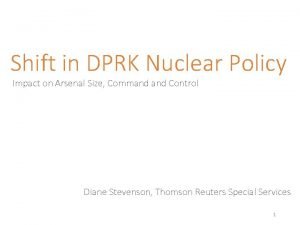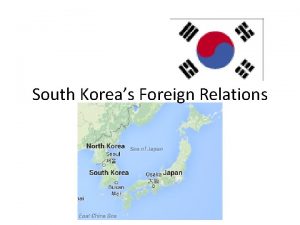South Koreas Foreign Relations South Koreas Strategic Posture














- Slides: 14

South Korea’s Foreign Relations

South Korea’s Strategic Posture • Political and security alliance with U. S. since the end of the Korean War in 1953 • The major issue is overwhelmingly North Korea – The “Sunshine Policy” of active engagement under President Kim Dae-Jung (1998 -2003) – Higher tensions under President Lee Myung-Bak (2008 -2013)

U. S. -Korea Free Trade Agreement • The “biggest trade deal since NAFTA” was passed by U. S. Congress in 2011. • During the negotiation process, both administrations faced opposition from strong domestic agricultural lobbies. – Korean rice farmers – U. S. cattle farmers • U. S. automobile industry

Korea-Japan Relations • Historical legacies date back two millennia • Cultural proximity – Language family – Written characters – Confucianism – Buddhism –. . .

Japanese Invasions • 1592 -1598, Japanese invasion was defeated by joint China-Korea forces. • 1894 -1895 war between Qing China and Japan over control of Korea. • 1904 -1905 war between Russia and Japan • 1910 Japan annexed Korea

Japan’s Occupation 1910 -1945 • Current historical issues: – Japanese statements of remorse for World War II – Korean laborers during World War II – Korean “comfort women” during World War II – Yasukuni Shrine (convicted war criminals) –. . .

Wartime Atrocities in the Relations • Kono Statement of 1993 – The statement, named after then Chief Cabinet Secretary Yohei Kono, contained a landmark apology to the sex slaves known euphemistically in Japan as “comfort women. ” • Murayama Statement of 1995 – Then socialist Prime Minister Tomiichi Murayama (1994 -1996) apologized for wartime suffering inflicted by Japan on its Asian neighbors.

Normalization of Relations 1965 • President Park Chung-Hee of South Korea established diplomatic relations with Japan. • Economic benefits • Resentment

Territorial Dispute • Dokdo (in Korean) / Takeshima (in Japanese) • South Korean government position: – “Dokdo. . . is an integral part of Korean territory historically, geographically, and under international law. ” • Japanese government position: – “Takeshima is clearly an inherent territory of Japan, in the light of historical facts and based upon international law. ”

Trading Partners • South Korea is Japan’s – 3 rd largest export market (8%) – 6 th largest source of imports (5%) • As South Korea’s export destination, Japan dropped from 3 rd place (7%) to 5 th (4. 9%) • As South Korea’s 2 nd largest import source, Japan’s share dropped from 12% to 10. 5% in 2015.

Trade and Investment 2010 2011 5. 96% Japan-South Korea total trade growth Japanese $1. 085 $2. 439 investment in billion South Korean investment in Japan 2012 2013 -4. 35% 10. 55% $3. 996 $3. 286 billion $559 $47 million

Role of US and China • US bilateral alliances with Japan and with South Korea respectively – Common concerns over North Korea’s nuclear program and China’s rising power • China is the top trade partner of Japan and of South Korea

South Korea’s Ties with China • Growing economic relationship with China • China passed the U. S. in 2003 to become South Korea’s largest trading partner • In 2015, 26% of South Korea’s exports went to China, nearly double the share for the U. S. • In 2015, 21% of South Korea’s imports came from China, more than the shares of Japan and U. S. combined.

South Korea’s New Role in Asia • Playing a “balancing” or mediating role in regional disputes – territorial disputes between China and Japan – nuclear standoff between North Korea and U. S. • Building Seoul into a logistics and business hub for the region • However, actual ability seems limited
 Too foreign for here too foreign for home
Too foreign for here too foreign for home Employee relations in public relations
Employee relations in public relations Io model strategic management
Io model strategic management Strategy analysis and choice largely involves making
Strategy analysis and choice largely involves making Strategic fit vs strategic intent
Strategic fit vs strategic intent Strategic complement
Strategic complement Proper keyboarding technique improves
Proper keyboarding technique improves Shoulder push stabilization screen
Shoulder push stabilization screen Postural assessment example
Postural assessment example Entry posture diagram
Entry posture diagram Decorticate posture gcs
Decorticate posture gcs Gothic shoulders posture
Gothic shoulders posture Nuclear posture
Nuclear posture Clothing and appearance
Clothing and appearance Overhead squat
Overhead squat


























